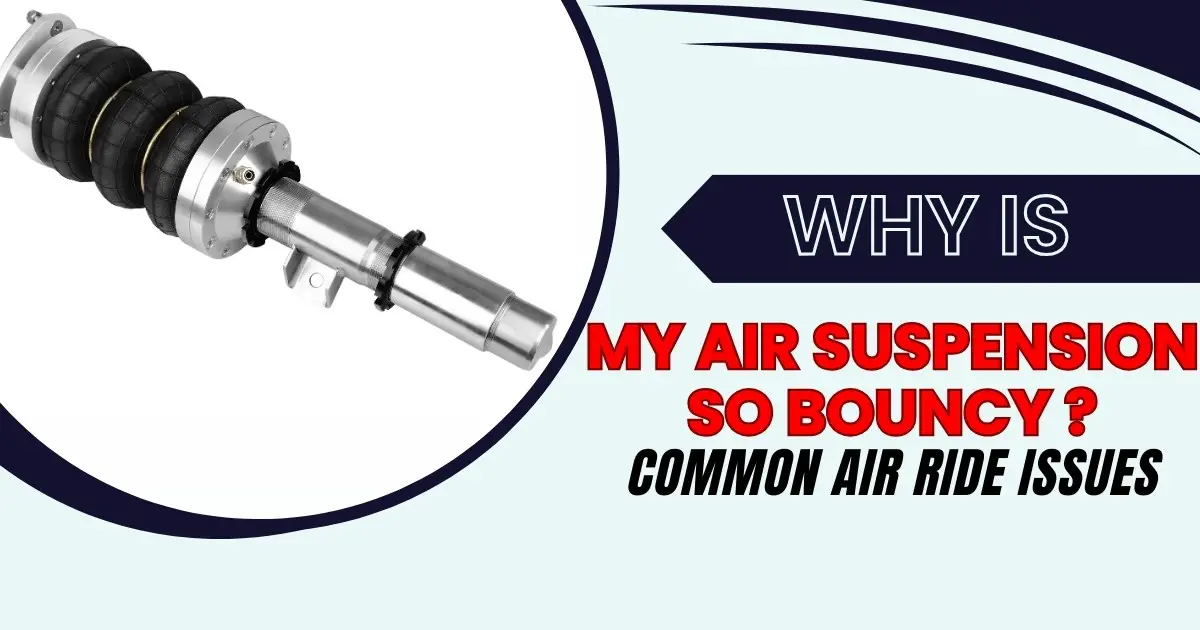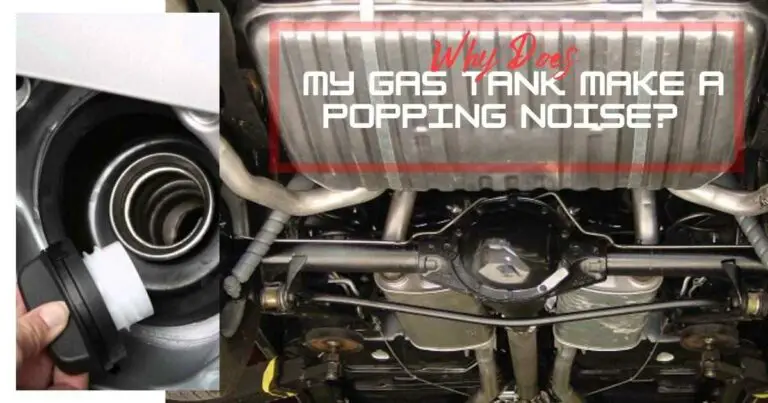Why is My Air Suspension So Bouncy? Common Air Ride Issues
Ever wondered how your car manages to glide over bumps and potholes with ease? It’s all thanks to the air suspension system! One of the key advantages of air suspension is its ability to deliver superior ride comfort and handling by allowing for adjustable ride height based on driving conditions or driver preferences.
However, the air systems can act up and make your car bounce unexpectedly. This issue can manifest as excessive bouncing or a lack of stability, detracting from the otherwise smooth and refined ride expected from air suspension. In this guide, we will tackle the elephant in the room and offer practical solutions to resolve bounciness in air suspension systems.
Overview of Air Suspension
An air suspension is a type of vehicle suspension system that utilizes air springs to provide a smoother and more comfortable ride. Instead of relying on metal springs found in traditional suspension systems, air suspension systems use air-filled rubber bags or bellows to absorb shocks and support the weight of the vehicle.
These airbags are typically made of reinforced rubber and are connected to an air compressor or air reservoir. Now, when your vehicle encounters bumps or uneven terrain, the air springs compress and expand to absorb the shock, resulting in a smoother ride for you and your passengers.
Air suspensions utilize the air compressor to continuously monitor and adjust the air pressure in the air springs to enhance comfort and handling. Additionally, some advanced air suspension systems employ electronic control systems that automatically adjust the suspension settings based on driving conditions.
That said, proper maintenance of air suspension systems is crucial for optimal performance and longevity. One of the most critical aspects of maintenance is ensuring that the air springs are inflated to the correct air pressure. Generally, improper inflation can lead to harsh rides and, consequently, reduced ride quality.

Why is My Air Suspension so Bouncy?
If you’re experiencing a bouncy ride with your air suspension, you’re not alone. Air suspension systems are designed to provide a smooth and comfortable driving experience, but issues can crop up, leading to excessive bouncing. Here are some of the common reasons why your air suspension might feel so bouncy;
Uneven Air Pressure
Air suspension systems rely on consistent air pressure across all air springs to maintain balance and stability. If there are variations in air pressure among the air springs, it disrupts the system’s equilibrium. As a result, one side of the vehicle may have more air pressure than the other, causing it to sit higher or lower than intended.
The imbalance in air pressure makes the suspension system less effective at absorbing shocks and vibrations from the road surface. As a result, the vehicle may exhibit increased bouncing or jolting motions, especially when driving over bumps or uneven terrain. This can lead to a less comfortable and more fatiguing driving experience for occupants.
Faulty Air Springs
Air springs are designed to absorb shocks and vibrations from the road surface, ensuring a smooth and comfortable ride. However, if these springs are damaged, they lose their ability to absorb impacts effectively, resulting in a bouncier and more jarring ride. This can be particularly noticeable when driving over bumps, potholes, or rough terrain.
Faulty air springs can also lead to an imbalance in the suspension system, causing one side of the vehicle to sag or sit lower than the other. This can result in uneven ride height, which not affects the aesthetics of the vehicle but also compromises its handling and stability. Additionally, imbalanced suspension can put a strain on other components, leading to more issues down the line.
Leaks in Air Lines
Leakage in the airlines or connections within an air suspension system can also lead to significant issues with performance and ride quality. If the system is experiencing leaks in the airlines, the air is bound to escape, leading to a gradual loss of air pressure.
As a result, the air springs may become underinflated, compromising their ability to support the vehicle’s weight and absorb shocks effectively. The reduced air pressure can, in turn, lead to a range of issues, including air suspension bouncing and instability while driving.
Without sufficient air pressure to cushion the ride, the suspension becomes less effective at absorbing impacts, resulting in a jarring and uncomfortable driving experience. Excessive bouncing can also affect the vehicle’s handling and stability, making it more difficult to maintain control on the road.
Damaged Compressor
The compressor is responsible for maintaining the proper air pressure within the air suspension system. It continuously monitors and adjusts the air pressure in the air springs to ensure optimal performance and ride quality.
However, if the compressor fails to operate as expected, it may struggle to maintain the required air pressure, leading to a loss of suspension support. As a result, the vehicle may experience increased bouncing and instability while driving.
Worn Suspension Components
Shocks and struts are vital components of the suspension system responsible for dampening vibrations and impacts from the road surface. When these components become worn out, they lose their ability to absorb shocks, leading to increased bouncing and instability. This can result in air ride suspension problems and a more fatiguing driving experience.
Worn shocks and struts are also bound to lose their ability to control the movement of the vehicle. This can manifest as excessive body roll, nose-diving during braking, or swaying during cornering. The compromised control over the vehicle’s movements can further exacerbate bouncing and reduce overall ride comfort and stability.
Other Common Air Suspension Problems and Solutions
Air Leaks
As mentioned, air suspension systems rely on air-filled bags or springs to support the vehicle’s weight. Over time, these bags or springs can develop leaks, causing the suspension to lose air pressure and sag or become uneven. Ideally, identifying and repairing air leaks promptly is essential to maintain the performance and reliability of the air suspension system.
You can use methods such as visual inspection, pressure testing, or the application of soapy water to detect leaks. Once identified, you can repair the leaks by replacing the damaged components, sealing punctures, or fixing any faulty connections in the airlines.
Compressor Failure
The compressor is responsible for pumping air into the suspension system. If the compressor fails, the air suspension will not be able to maintain the desired ride height, leading to a harsh or uneven ride. As a result, the vehicle may experience a harsh or uneven ride, as well as a sagging suspension. In some cases, the vehicle may even sit lower than normal, impacting its handling and stability.
Without proper air pressure in the suspension system, the vehicle may also be more susceptible to bottoming out on bumps or rough roads, leading to discomfort for the occupants and potential damage to other suspension components.
Repairing compressor failure typically involves replacing the faulty compressor unit. Furthermore, regular maintenance, including checking the condition of the compressor and ensuring it is free from debris or obstructions, can help prevent compressor failure and ensure the proper functioning of the air suspension system.
Faulty Air Springs or Struts
Faulty air springs or struts can significantly impact the performance and comfort of a vehicle’s air suspension system. As the air springs lose their ability to maintain pressure, the suspension may sag, causing the vehicle to sit lower than normal. This can lead to reduced ground clearance and compromised handling.
In addition, worn-out or damaged air springs or struts may no longer provide sufficient damping, leading to a bumpy or jarring ride quality. This can result in discomfort for passengers and increased wear on other suspension components.
Electrical or Sensor Problems
Modern air suspension systems are controlled by electronic sensors and modules. Electrical faults or sensor malfunctions can cause the suspension system to behave unpredictably, leading to sudden changes in ride height, uneven suspension, or a bumpy ride. This can compromise the vehicle’s stability and handling characteristics, posing a safety risk.
In some cases, electrical issues or sensor malfunctions can prevent the air suspension system from operating altogether. This can result in a complete loss of suspension functionality, causing the vehicle to ride harshly and potentially damaging other suspension components.
Keeping the system clean, well-lubricated, and free from debris or corrosion is a great way to prevent future electrical problems and prolong the lifespan of suspension components. You may also want to implement a regular maintenance schedule for the air suspension system, including periodic inspections and servicing of electrical components and sensors.
Suspension Control Module Failure
The suspension control module is responsible for coordinating and controlling the various functions of the air suspension system, including adjusting ride height, damping characteristics, and overall suspension performance. However, it can fail due to several reasons, such as water damage, electrical faults, or software glitches.
When the suspension control module fails, it may cause inconsistent or erratic suspension behavior, such as sudden changes in ride height or stiffness. It can also lead to loss of functionality, where the air suspension system fails to respond to driver inputs or adjustments.
Fixing a faulty suspension control module typically requires professional diagnosis and repair by a qualified technician or dealership service center. Depending on the extent of the damage, repairs may involve replacing the faulty module, reprogramming the software, and addressing underlying electrical issues.
Overheating
Overheating in an air suspension system often occurs due to continuous operation or excessive load. If the compressor overheats, it may malfunction or fail, leading to a loss of air pressure in the suspension system. This can result in issues such as sagging suspension, uneven ride height, or a harsh ride.
To prevent compressor overheating, it’s essential to avoid overloading the vehicle and to allow the compressor to cool down periodically during extended periods of use. Regular maintenance, including checking the compressor for proper operation and ensuring adequate airflow, can also help prevent overheating issues.
Tips for Maintaining Air Suspension
- Schedule routine inspections of the air suspension components, including air springs, struts, the air compressor, and airlines. Look for signs of wear, leaks, or damage, and address cropping issues as soon as possible.
- Schedule routine inspections of the air suspension components, including air springs, struts, compressor, and air lines. Look for signs of wear, leaks, or damage, and address any issues promptly.
- Regularly check the air pressure in the air springs using a reliable pressure gauge. Inflate or deflate the air springs as needed to maintain the recommended pressure levels for optimal ride quality and vehicle stability.
- If you notice any air leaks in the system, such as hissing sounds or visible air loss, address them promptly. Inspect air lines, connections, and air springs for leaks, and repair or replace damaged components as necessary.
- Maintain cleanliness around air suspension components to prevent debris, dirt, or contaminants from entering the system. Clean air intake vents, compressor filters, and airlines regularly to ensure unobstructed airflow and efficient operation.
- Adhere to the vehicle’s weight limits and avoid overloading, as it can strain the air suspension system and lead to premature wear or damage..
- Avoid rough or aggressive driving maneuvers that could put excessive stress on the air suspension components. Drive cautiously over bumps, potholes, and rough terrain to minimize impact and reduce wear on the suspension system.
- If applicable, keep the air suspension system’s control module up to date with the latest software updates provided by the manufacturer. These updates may include performance enhancements or bug fixes to improve system reliability and functionality.
- Explore options for upgrading to high-quality aftermarket components or performance-oriented air suspension kits to enhance ride comfort, handling, and durability.
Conclusion
We believe that this guide has answered your question on why your air suspension may feel so bouncy. When answering this question, it is important to remind you that safety is paramount. If you’re experiencing any irregularities in your vehicle’s suspension or handling, you may want to take appropriate actions as soon as possible to help prevent more significant problems down the line.






